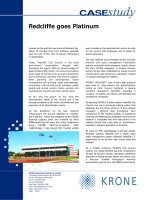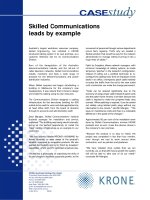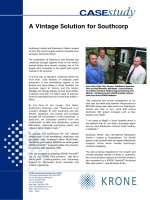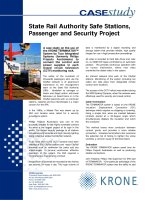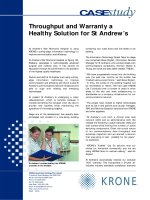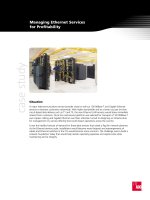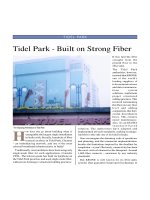Tài liệu Case Study - Telco - Managing Ethernet Service pdf
Bạn đang xem bản rút gọn của tài liệu. Xem và tải ngay bản đầy đủ của tài liệu tại đây (592.46 KB, 4 trang )
case study
Managing Ethernet Services
for Profitability
Situation
A major telecommunications service provider chose to roll-out 10/100Base-T and Gigabit Ethernet
services to business customers nationwide. With higher bandwidth and at a lower cost per bit than
circuit-based data delivery such as T1 and T3, the new Ethernet LAN services would draw immediate
interest from customers. Once the multi-service platform was selected for transport of 10/100Base-T
over copper cabling and Gigabit Ethernet over fiber, attention turned to designing an infrastructure
for management of a service offering that could impact operations across the country.
It was the healthy forecast of demand for these data services that raised a flag for network planners.
As the Ethernet services scale, installations would become more frequent and rearrangements of
cables and Ethernet switches in the CO would become more common. The challenge was to build a
network foundation today that would help restrain operating expenses and capital costs while
maintaining service integrity.
Solution
Borrowing upon years of managing volume processes for voice services, network planners decided that
the infrastructure for new Ethernet services should be uniform across all COs. In addition, it should offer
efficiencies for adding customers, installing and upgrading Ethernet switches, and making other changes
and rearrangements as required.
ADC engineers proposed cabling Ethernet equipment in each CO to a centralized cross-connect called
an Ethernet Distribution Frame (EDF). By creating a common craft interface for adds, upgrades, and
rearrangements on Ethernet equipment, the EDF would enable change without service disruptions. The
EDF provides a logical and easy-to-manage infrastructure due to two design characteristics:
• All network elements have permanent equipment cable connections that are, once terminated, never
handled again.
• All changes, circuit rerouting, upgrades, maintenance and other activities are accomplished using
semi-permanent patch cords on the front of the EDF cross-connect bay.
10/100/1000
ETHERNET
5800 SERIES
Worx
Power
1
1
1
1
10/100/1000
ETHERNET
5800 SERIES
10/100/1000
ETHERNET
5800 SERIES
10/100/1000
ETHERNET
5800 SERIES
10/100/1000
ETHERNET
5800 SERIES
10/100/1000
ETHERNET
5800 SERIES
10/100/1000
ETHERNET
5800 SERIES
10/100/1000
ETHERNET
5800 SERIES
10/100/1000
ETHERNET
5800 SERIES
10/100/1000
ETHERNET
5800 SERIES
10/100/1000
ETHERNET
5800 SERIES
10/100/1000
ETHERNET
5800 SERIES
10/100/1000
ETHERNET
5800 SERIES
10/100/1000
ETHERNET
5800 SERIES
10/100/1000
ETHERNET
5800 SERIES
10/100/1000
ETHERNET
5800 SERIES
10/100/1000
ETHERNET
5800 SERIES
10/100/1000
ETHERNET
5800 SERIES
10/100/1000
ETHERNET
5800 SERIES
25-pair cables
The central EDF cross-connect bay consists of 5800 Series panels and Glide Cable managers mounted on
the sides of each rack. Cross-connecting Ethernet equipment is accomplished with RJ45 patch cords. Active
Ethernet network element bays include two 5800 Series panels with permanent connections to Ethernet
equipment and the EDF.
Ethernet Equipment Frame
Ethernet Distribution Frame (EDF)
Conserving Capital
At the heart of the EDF is the Glide Cable
Management system. These cable management
troughs bolt onto the side of standard frames and
provide integrated front, rear, horizontal and
vertical cable management. This eliminates
horizontal cable managers, frees valuable rack
space, and effectively doubles rack density. EDFs
equipped with competitive cable management
systems could only manage up to 456 Ethernet
terminations for this application. However, the
service provider was able to accommodate 912
Ethernet terminations on EDFs using ADC’s Glide
Cable Management system—saving valuable floor
space and reducing the need in some COs for new
construction.
With the possibility that some Ethernet switches
may be placed far from the EDF, one issue facing
network planners was overcoming the 100-meter
Ethernet distance limitation on copper. Fiber
cabling and ADC's carrier-class OptEnet optical
extension platform allowed Ethernet elements
throughout the central office to be connected to
the EDF. The 10Base-T and 100Base-T auto-
negotiation feature within a single port would
enable the service provider to upgrade service
without replacing line cards in the transport
device—again helping to conserve capital. The
system, which can be accessed and monitored
remotely, supports 12 Ethernet ports in a 2RU
footprint. Multiple variations of line cards can be
deployed in the chassis ranging from 10Base-T to
Gigabit Ethernet copper interfaces with transitions
to single mode or multimode fiber.
Containing Operating Expenses
To reduce installation time and errors, the EDF includes 5800 Series patch panels for handling permanent
Ethernet cable connections and creating the patch field for managing moves, adds and changes. Each
5800 panel features RJ45 connectors on the front and 25-pair RJ21x connectors on the rear. Experience
showed that RJ21x rear terminations shaved cable installation time to about 2 minutes for each 24-port
panel—compared to nearly one hour for each 24-port panel with 110 punch-down terminations. As the
Ethernet service offering grows, installation savings would be significant.
In addition, RJ21x connectors reduced installation errors common with 110 punch-down terminations
such as crossed wires and pairs untwisted too far that often disables valuable ports on Ethernet
equipment. Use of pre-terminated, 100% factory tested RJ21x Category 5e cable assemblies to connect
5800 distribution panels in active Ethernet bays with 5800 panels in the EDF ensured high quality
terminations and less rework in the CO.
ADC Telecommunications, Inc., P.O. Box 1101, Minneapolis, Minnesota USA 55440-1101
Specifications published here are current as of the date of publication of this document. Because we are continuously improving our products, ADC
reserves the right to change specifications without prior notice. At any time, you may verify product specifications by contacting our headquarters
office in Minneapolis. ADC Telecommunications, Inc. views its patent portfolio as an important corporate asset and vigorously enforces its patents.
Products or features contained herein may be covered by one or more U.S. or foreign patents. An Equal Opportunity Employer
1260780 5/04 Revision © 2003, 2004 ADC Telecommunications, Inc. All Rights Reserved
Web Site: www.adc.com
From North America, Call Toll Free: 1-800-366-3891 • Outside of North America: +1-952-938-8080 Fax: +1-952-917-3237
For a listing of ADC’s global sales office locations, please refer to our web site.
Ensuring Signal Integrity and Service Availability
Using a cross-connect with proper cable management is, in itself, a standard practice at the service
provider. Migrating this practice from voice services to new Ethernet data services would be a natural
evolution for the operations staff. The ability to make additions and changes without handling active
equipment cables not only saves technician time but also protects equipment cables and sensitive ports
on active equipment. The Glide Cable system actually enforces logical routing of both jumpers and
equipment cables so that the frame remains organized and easy-to-manage even after many changes
have occurred. Built-in bend radius protection and generous cable storage ensure that the high-density
EDF frame allows easy access for moves, adds and changes without service disruptions.
It was just as important to manage fiber cables used for intra-office communications between the EDF
and Ethernet switches more than 100 meters distant. Fiber Management Trays were added to the design
for termination and storage of fibers. Each of the rack-mount, front access trays handle up to 32 fibers in
one RU of space and includes sliding adapter packs for easy access to connectors for installation and
routine maintenance. Across the EDF, the details of cable management make all the difference in
extending service life of cables and Ethernet ports while creating higher quality service for customers.
Conclusion
Spending just 1% to 2% additional capital to implement an Ethernet distribution system is a small
investment that yields big returns—decreases in both capital and operating expenses. The EDF eliminates
handling of active equipment cables on Ethernet switches, reducing downtime and speeding installation
and troubleshooting. By implementing a cross-connect infrastructure for Ethernet services, the service
provider is able to deliver Ethernet services at a lower cost while maintaining a level service integrity that
engenders customer loyalty.
Ethernet Distribution Frame
• Glide Cable Management with Slack Management Spools – ADCCMS-12
• 5800 Series Patch Panels – ADCPP245800BTEL
• OptEnet Optical Extension Platform – ADCCCE1100A (chassis), ADCCE2400A (power), ADCCE3000A
(SNMP), ADCPE4200A (10/100Base-T/SM SC), ADCPE5100A (gigabit/SM SC)
• Fiber Management Trays (FMT) – FMT-DST070A00-S12P
• PowerWorx Power Distribution Products – PWX-002RGCSD10PWDP & PWX-002FGCSD10PWDP


